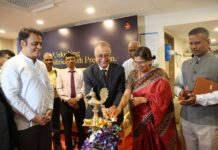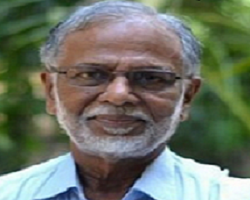Dr. T Jacob John is retired Professor and Head, departments of clinical virology and microbiology, Christian Medical College (Vellore), and was Director of the ICMR’s Centre of Advanced Research in Virology. He is credited with the establishment of India’s first diagnostic virology laboratory, and has conducted pioneering research in the fields of infectious diseases, clinical virology, and epidemiology. His model of polio control in Vellore and North Arcot district (Tamil Nadu) inspired global polio eradication. He is the recipient of the BC Roy Award for Eminent Medical Man of the year, 1990, and BR Ambedkar Centenary Award, 2002 – among other distinctions. He has also served as President of Indian Academy of Pediatrics and Indian Association of Medical Microbiologists, and is Fellow of the Indian National Science Academy.
In an exclusive interview to our Executive Editor Dr. Soham D. Bhaduri, Dr. John shares his insights and perspectives on the COVID-19 pandemic and India’s epidemic preparedness.
- What are the components of a nation’s epidemic preparedness and response system? How would you rate India in this respect, particularly in view of the previous outbreaks that we’ve withstood (like H1N1)?Epidemics may be of already endemic diseases or newly introduced ones. The present pandemic is an unprecedented one – influenza pandemics are similar, but far less virulent. In modern medicine, health management has three components: public health, to address environmental and social (societal) determinants of diseases and that way to prevent and control diseases; healthcare, to treat all un-prevented diseases; and research, to continuously tweak both and keep raising the bars of both. 2009 pandemic influenza came and India had introduced lab diagnosis and oseltamivir therapy. Both in healthcare mode. We don’t have public health – hence no public health surveillance, hence no reliable or reasonably complete data on the extent of the pandemic spread in India or the case-fatality. All large hospitals saw a lot of pregnant women dying with H1N1 – no numbers. Integrated Disease Surveillance Programme (IDSP) is an inefficient method, neither fitting the definition of public health surveillance, nor that of integrated system. Yes, we ‘withstood’ the pandemic, but did not learn the right lessons. We have no flu control programme. Lab diagnosis is confined to H1N1, neglecting H3N2, B. Yamagata, B. Victoria. The reported case-fatality in India of H1N1 is between 3% and 15%, while the world over it is in the order of 0.1%. Health Ministries, Union & State, are not worried.
- You have observed previous outbreaks like SARS 2003 and H1N1 2009. What according to you are the distinctive traits of the SARS-CoV-2 that has propelled it to being such a global menace?Each pathogen has three distinct features: how and where they amplify; how they transmit or spread; and what its host-microbe interactions are. No two pathogens are identical in any of the three. So, SARS-CoV-2 has its unique traits. Amplifies in upper respiratory tract, like flu; transmits by droplets and fomites, apparently more efficiently than flu. Flu has short incubation period, hence short generation time: SARS-CoV-2 has longer incubation period and longer generation time. So it goes from country to country slower than flu and epidemic curve is larger than that of flu. Host-virus interactions are not well defined in the severe cases. Humans have receptors for flu and Sars-Cov-2 in upper respiratory tract but only SARS-CoV-2 receptors in lungs. In severe cases, some very peculiar reactions take place interfering with oxygen carrying capacity of red cells and resultant organ/tissue hypoxemia results in multi-organ failure, rather like severe sepsis.
- You have opined elsewhere that India adopted a reactive rather than proactive approach towards COVID-19 since inception. In hindsight, how would you outline such a proactive approach that India should have adopted, in terms of measures and policies such as testing, enforced social distancing etc.?Not only India but a lot of other countries too. But others realised their mistakes sooner than India. Without going into details, let me say that even now the strategy is to respond where the virus has shown up. Introduction is monitored and then contact tracing. That is all good, and such reactive steps are appropriate to reduce importation-related expansion of infection. Once several introductions and their second and third generation infections were noticed, the strategy should have been shifted to interventions in anticipation of projected numbers and resultant healthcare needs. In healthcare, we emphasise ‘evidence-based’ responses. In epidemic control, evidence-based lessons must be supplemented by projection-based defence building. That ‘healthcare thinking contamination’ of public health strategy is what I mean reactive rather than proactive. Testing was predominantly for the purpose of detecting infected persons with the objective of preventing further transmission – to protect the uninfected. That is not for the health of the tested person. That I call ‘public health testing’. Excellent strategy as long as infected persons are limited in numbers and chains of transmission not too many. The term ‘community-transmission’ was invoked and until the first week of April the government was saying they have not seen the evidence of community transmission. So, evidence-based response did not demand response to community transmission. Absence of evidence is not evidence of absence. There are too many anecdotal stories of someone getting infected without known contact with diagnosed infection. That is indicative of community transmission. Testing is grossly inadequate in volume considering the fact that community transmission started two weeks ago. What is seen as Covid-19 today is the result of infection two weeks ago. On March 25th, lockdown was declared, confirming that Prime Minister was convinced of community transmission.Physical distancing has been practiced the world over; so India adopting it was just imitation. India has greater density of population than many others, hence physical distancing by lockdown would be fine in middle class and upper class dwellings, not poor, slums, migrant workers etc. If we were autonomously developing our own strategy, universal mask use should have been mandated by the beginning of March. Even now it is not mandated. A lot of infections are asymptomatic; such infections also result in spread. Mask reduces droplet spray drastically and minimises transmission. When an uninfected person wears a mask, he is partially protected from droplet infection. When both parties wear mask, transmission is near-100% blocked. Mask prevents fingers reaching nostrils or mouth. Finally, if all wear masks everyone in reminded of the pandemic.
- We are witnessing a rapid surge in COVID-19 cases. However, we haven’t had the kind of exponential increase that say Italy (which also recorded its first case in January end) has seen, controlling for measures like a nationwide lockdown. How do we explain this, and does this point at any advantageous feature in India’s case?I have said that the spread is as efficient as for flu, but generation time is longer than for flu. So exponential increase is a feature after several weeks of introduction. Both Italy and India had introduction of the coronavirus from China by February 2. However, we have very few introductions during February. Italy presumably had many more introductions in February. By February end, we were getting importations from Italy, indicating infection had ‘taken off’ in Italy.In Italy, exponential growth was at several foci but in India it was in only 2 foci – Kerala and Pune.Now it is about time for India to catch up with Italy and the first week of April is showing rapid expansion. This kind of slow beginning and gradual increase in ‘mass and momentum’ is aptly represented by my simile of ‘avalanche’. In short, our advantage was lower volume of traffic with China. Nation-wide lockdown was unplanned but sudden. Therefore, states and local governments did not have any plans in communities. Therefore, lockdown was not complete in many cities and towns. Also guest labourers (migrant workers) were not handled well. Moreover, thickly populated communities, like slums, could not keep families with required physical distancing. In villages and the middle-class and above communities it works well, but not in the above situations. The full benefit of a lockdown is not reaped – the rapid increase in numbers positive during lockdown period illustrates that failure.
- We are keenly looking forward to a medical cure and a vaccine for SARS-CoV-2. Given the known aspects of the disease and the virus, do you think a specific treatment or a vaccine will contribute significantly to curbing COVID-19 as a public health problem?I drew the similarity with flu pandemic; after pandemic wave, flu became globally endemic. So we must anticipate that COVID-19 will also become pan-endemic. Flu H1N1 causes death, annually, in unknown numbers of people in India. So, endemic COVID-19 will also cause a number of deaths annually. Like flu vaccine is used in many countries to reduce morbidity and mortality, we will need a COVID-19 vaccine too. We will have a vaccine by 2021; as for effective antiviral drug to treat COVID-19, we can only hope for success, but can’t make predictions. These innovations need intensive basic research. I am disappointed that India lags behind many European countries in this regard.
- How do you reckon the COVID-19 pandemic to pan out from here, for India and the world? Do you anticipate a persistent, lingering threat?I expect the pandemic wave to dwindle after a majority becomes immune due to infection. Thereafter the infection will (in all probability) become pan-endemic, endemic in all countries. We cannot expect SARS-CoV-2 to commit hara-kiri.
- Taiwan’s success in confronting COVID-19 has been ascribed to its learnings from SARS 2003. What lessons should India derive, even as the COVID-19 pandemic recedes, in terms of epidemic preparedness and response?India also had experience with SARS; we had three confirmed cases. We also had a systematic approach, spearheaded by the Directorate General of Health Services. No institutional memory, no lessons, no legacy. We eradicated smallpox; no legacy. We eradicated wild polioviruses; no legacy. We face every challenge on ad hoc basis. Our health management system remains fragile and inadequately designed and funded. I hope that India will design and establish public health; strengthen and streamline healthcare with quality and equity; heavily fund research for reaping immense profit from people’s health as well as innovative products – diagnostics, therapeutics and vaccines.
-Views expressed in this interview are of the expert’s own.
























